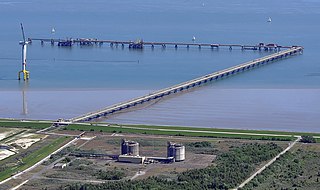
Brunsbüttel is a town in the district of Dithmarschen, in Schleswig-Holstein, northern Germany that lies at the mouth of the Elbe river, near the North Sea. It is the location of the western entrance to the Kiel Canal.

Liquefied natural gas (LNG) is natural gas (predominantly methane, CH4, with some mixture of ethane, C2H6) that has been cooled down to liquid form for ease and safety of non-pressurized storage or transport. It takes up about 1/600th the volume of natural gas in the gaseous state (at standard conditions for temperature and pressure).

A floating production storage and offloading (FPSO) unit is a floating vessel used by the offshore oil and gas industry for the production and processing of hydrocarbons, and for the storage of oil. An FPSO vessel is designed to receive hydrocarbons produced by itself or from nearby platforms or subsea template, process them, and store oil until it can be offloaded onto a tanker or, less frequently, transported through a pipeline. FPSOs are preferred in frontier offshore regions as they are easy to install, and do not require a local pipeline infrastructure to export oil. FPSOs can be a conversion of an oil tanker or can be a vessel built specially for the application. A vessel used only to store oil is referred to as a floating storage and offloading (FSO) vessel.
LNG Hrvatska d.o.o. is a company that operates a floating liquefied natural gas (LNG) regasification terminal in Omišalj on the island of Krk, Croatia. It commenced operations on 1 January 2021, with full capacity booked for the next three years.
Golar Spirit is a floating storage and regasification unit (FSRU). It is the world's first FSRU converted from a liquefied natural gas (LNG) carrier.

Qatar Gas Transport Company Limited, commonly known as Nakilat is a Qatari shipping and maritime company. Its LNG shipping fleet is the largest in the world, comprising 74 vessels. The company also jointly owns one Floating Storage Regasification Unit (FSRU) and 4 very large LPG carriers (VLGCs). Through its in-house shipmanagement, Nakilat manages and operates the four very large LPG carriers and 14 LNG carriers.
Klaipėdos Nafta (KN) is an oil and LNG terminals operator based in Klaipėda, Lithuania. The company was founded in 1994. The company operates the Klaipėda Oil Terminal, Subačius oil terminal, Klaipėda LNG terminal, Açu LNG terminal (Brazil) and Klaipėda small-scale LNG reloading station.

The Świnoujście LNG terminal is a liquefied natural gas (LNG) import terminal at Świnoujście, in the extreme north-west of Poland near the Polish-German border. The LNG terminal is operated by Polskie LNG S.A., a subsidiary of Gaz-System. The cornerstone for construction was laid on 23 March 2011 and it took its first LNG delivery on 11 December 2015. The terminal's regasification capacity is 5 billion cubic metres per annum. The terminal is currently being expanded and once the expansion is complete in 2023, it will have a capacity of 7.5 billion cubic metres per annum and be able to satisfy about half of Poland's annual natural gas demand. Together with the 10 bcm of natural gas that Poland will receive annually from Norway via the Baltic Pipe natural gas pipeline, the Świnoujście LNG terminal will allow Poland to achieve its long-term goal of becoming fully independent of Russian natural gas, which had previously been the source of almost all of the country's natural gas.

A liquefied natural gas terminal is a facility for managing the import and/or export of liquefied natural gas (LNG). It comprises equipment for loading and unloading of LNG cargo to/from ocean-going tankers, for transfer across the site, liquefaction, re-gasification, processing, storage, pumping, compression, and metering of LNG. LNG as a liquid is the most efficient way to transport natural gas over long distances, usually by sea.
Deutsche Umwelthilfe e.V. is a non-profit environmental and consumer protection association, supported by public and private project grants and donations. It is a member of the European Environmental Bureau, in Brussels. It has the legal right to represent group claims in court against projects that it considers a threat to the environment. The group also aims to provide a forum for dialogue between environmental organizations, politicians and business people.
Grain LNG Terminal is a Liquefied Natural Gas (LNG) terminal on the Isle of Grain, 37 miles (60 km) east of London. It has facilities for the offloading and reloading of LNG from ships at two jetties on the River Medway; for storing and blending LNG; for truck loading; and regasifying and blending natural gas to meet UK specifications. The terminal can handle up to 15 million tonnes per annum of LNG, has storage capacity for one million cubic metres of LNG, and is able to regasify up to 645 GWh per day for delivery into the high pressure gas National Transmission System (NTS). The facility is owned and operated by National Grid Grain LNG Ltd, a wholly owned subsidiary of National Grid.
MT GDF Suez Neptune is a liquefied natural gas (LNG) carrier, which has been used as a floating storage and regasification unit (FSRU) for LNG at the Aliaga Etki LNG terminal in Aliağa district of İzmir Province, western Turkey between 2016 and 2019.
MT MOL FSRU Challenger is a Bahamas-flagged liquefied natural gas (LNG) carrier, which is currently laid up in Singapore.

Wilhelmshaven LNG terminal is Germany's first liquefied natural gas (LNG) shipping terminal, situated near Wilhelmshaven, Germany on the North Sea. It had been in the planning stages since the mid-2010s, and in 2022 gained rapid regulatory authority approval for construction following the Russian invasion of Ukraine and the global natural gas supply crisis.
MT Botaş FSRU Ertuğrul Gazi is a South Korean-built Turkey-flagged offshore support vessel certified as a floating storage regasification unit (FSRU) for liquified natural gas (LNG). She is owned by the Turkish petroleum and natural gas pipeline corporation BOTAŞ, and operated by the Norwegian maritime company Wilhelmsen Ship Management, serving at Botaş Dörtyol LNG Storage Facility in southern Turkey. This is the country's first vessel of this type.
The Lubmin LNG terminals are two liquefied natural gas (LNG) terminals in Lubmin, Mecklenburg-Vorpommern, Germany, on the Baltic Sea. Both shipping terminals were rushed into operation following the 2022 Russian invasion of Ukraine and the global natural gas supply crisis and the loss of Russian pipeline gas, which had long provided over fifty percent of German gas energy demand.
Inkoo LNG terminal is a liquefied natural gas (LNG) shipping terminal, situated near Ingå, Finland on the Gulf of Finland. It became operational in January 2023, and received first gas in April 2023, with some shipments for Estonia. The floating regasification equipment and port facility was built to offload marine-shipped LNG to Finland following the cutoff of Russian pipeline gas in the aftermath of the 2022 Russian invasion of Ukraine, and will have the capability over time to supply gas to the Baltic countries as well.







